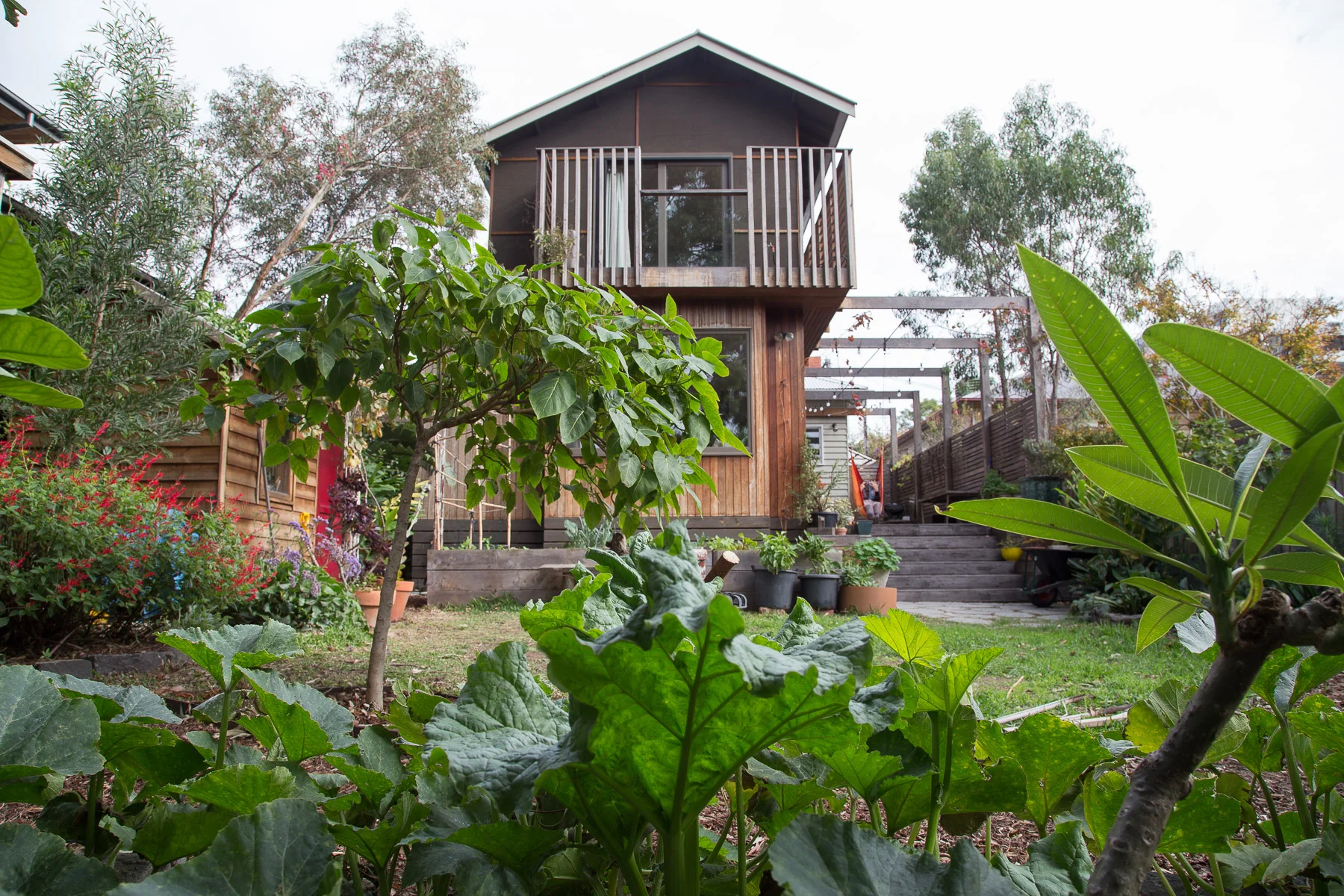Recently I have revisited the process I went through when we renovated our own home, in an article written for Australian permaculture magazine Pip - the Design issue.
Eight years ago we bought a dilapidated 1940’s Californian bungalow in Melbourne’s inner northern suburbs. It was in a semi-derelict state and had a heritage overlay, flood level restrictions and a long narrow bloc. However the site was extremely special as it backed onto the Merri creek wildlife corridor. The real value for us was not in the bricks and mortar but in the proximity of the majestic, mature gum trees, running water and the deep buffer of native vegetation on either side of the creek, creating a peaceful sanctuary in an urban environment. We began the process of retrofitting and renovating the home by thinking of it as part of a permaculture system that would integrate the built, interior and biological environments and in turn create an urban existence for our family that allowed us to connect to nature and our local community on a daily basis. There are some key ways of thinking about design from a permaculture perspective based on the ethics and principles as defined by Bill Mollison and David Holmgren - and below I have outlined how I applied some of these principles in our process.
OBSERVATION: As we designed the renovation it was important to observe the building over a full seasonal year by spending time on the site and noticing the patterns of the elements - sun, water, wind - in order to harness them for use in our home.
CAPTURING ENERGY: All buildings have some potential for passive function that can be realised. In order to make the 1940’s weatherboard home thermally efficient we took the whole building apart piece-by-piece and back to its structural frames. We then wrapped it in insulation and put it all back together again, sealing every little gap as we went. The process has a sense of the loving act of mending the holes in your favourite coat. The extension was built on a suspended concrete slab that allowed us to introduce a thermal mass capacity into the home. We located new windows to open up the home to the winter sun, shade ourselves from the summer heat and to capture cooling breezes. We re-oriented the room layout so that all living areas faced north, flooding the spaces with natural light and allowing the winter sun to reach its long fingers inside.
PATTERNS OF USE: By reconfiguring the layout of the existing home and extending it, we resolved the spatial design around patterns of use. This design solution creates healthy and resourceful living so that the home functions with the ‘path of least resistance’. Our common utility areas butt up against the social areas so that no one feels like they are in purgatory while doing washing in the laundry. When it’s raining, we can walk barefoot in the house under a clear roof off the deck to hang washing outside. Living in the new home our daily tasks and rituals are now performed in an ergonomic, logical and enjoyable fashion. The best ‘storage vessel’ for the heat and energy of the sun is the human body. Ideally we can wake up to the sun, eat breakfast with it streaming through the window and then relax at the end of the day while watching it set.
RESOURCEFULNESS: During the construction process, we sought to produce the minimum amount of waste possible by first looking at what we had around us, and making the most of existing and discarded materials. Demolished materials such as cabinetry and architectural features were collected and stored for reuse, resold, or collected for further recycling. We repaired or partially replaced what we could - salvaging undamaged weatherboards; collecting the old hardwood skirtings and architraves; and sourcing additional salvaged timbers, doors, and fixtures. We consistently placed value on the marginal - the little details and elements of a design that brought character and resourcefulness to our family home. Every cupboard handle, every window winder, every material junction is where you have the opportunity for the greatest change.
salvaged brass door handles and timber doors were used
TIME: The design process requires great consideration, testing and evolution over time. For every week we spent in design consideration the project continued to improve. This also allowed for a nuanced design solution in direct response to our community relationships and collaborations. Clear and honest communication between the whole team was so important to ensure we shared our vision and considered everyone’s concerns. This slow and evolving approach to design reprioritises the experience and connection between people over the goal of a rushed completion date. Our home has been allowed to beautifully ‘cure’ over time, retaining the potential for future adaptations . By using materials that are only fully realized when their natural patinas show up over time, it is then that our home starts to come alive. In our house, I try to choose special pieces that are worth keeping, appreciating the skill and materiality of highly-crafted objects that ultimately create heirlooms.
Secondhand light fitting and furnishings have been used throughout
BREVITY: I had to curb my enthusiasm for collecting stuff and taking up more space. Our cupboards were intentionally designed not to be too deep in order to avoid things disappearing into the dark zone of being too far away. We created one large central space that opened up to the same amount of outdoor decking. It has become a home where we can welcome our extended community, it can be used as a shared resource and has allowed us to host community groups and events. We also welcome help-exchangers and the neighbourhood children at spontaneous hours of the day. Our bedrooms and utility rooms are modestly sized and shaped for their intended use. Bathrooms and the laundry are long and thin to maximise wall space, access to light and minimise unnecessary circulation space. High loft beds in the kids bedrooms create more floor space for them to play. The hallway was made just wide enough to run a desk along its length and create an office area without dedicating a room to that purpose. The roof space has been lined and fitted out with pull down ladders to store seasonal gear. We also have cupboards that run to the ceilings above normal head height so desks and beds can fit underneath. These design outcomes maximize the use of our precious vertical space.
LIVING ON THE EDGE: Typically, the edges in nature contain the most dense diversity and activity and this includes human inhabited spaces. We paid special attention to articulating the spaces on the edge, from the outside to in, from public to private, from down to up. These transition spaces are where people interact the most with one another, and blurring these boundaries can create opportunities for dynamic relationships and communication. We removed any high fences from the front yard so we could talk to our neighbours and passers-by on the street whilst working in the garden. We created a small door in the back garden fence so that the younger children next door could come and go without needing to be walked along the street. Our delight never ceases when our littlest and most curious neighbours pop up in our garden and kitchen. We created a pergola structure to reach the boundary. It provides both summer shade to the north-facing windows but also houses a vertical recycled hardwood screen, creating some privacy and a vertical surface to grow grapes, berries and honeysuckles. Between the backyard and the creek we took down the tall paling fence and replaced it with a low open wire fence. This allows us to observe the creek beds' native vegetation and wildlife. Another two houses in the area have since followed suit, and now our chickens forage periodically on the creek-side saving us cutting back grasses and weeds and providing them (and us) an abundant source of food.
STACKING FUNCTION: We sought to integrate diverse design problems into one solution, maximising the use of the available space. We created play-nooks under the loft and in the fireplace alcoves (these will later become study nooks and book shelves when the kids get older). We use the laundry as an indoor drying room as well as a bulk-goods store. We have located our solar hot water tank inside an otherwise useless space at the top of the stairs so we can dry wet boots, make yogurt and maybe even hatch eggs in the warm cupboard.
INTEGRATION: I sought out ‘responsive’ materials, finishes and furnishings, by selecting items with a tangible context that relate to the region or have a historical or emotional relationship to us. This enabled me to explore an authentic regional and personal design vernacular. Our home is lovingly filled with hand-me-downs from our family and objects that we have collected, made, salvaged, and found over the years. This means our home does not have a particular look, but is more an accidental collection of personally significant things, gently curated into a pleasing combination of usefulness and decoration.
A YEILD: Our home has produced outcomes far beyond aesthetic and economic results. We have fresh healthy food, happy children, meaningful friendships and connection with our community. There isn’t a person that worked on this house that didn’t speak warmly of their experience, despite having to carry everything in down steep muddy paths. We would sometimes stop work to gently relocate wildlife that kept moving into the building site, such as the little ring-tail possum found asleep in the middle of a cloud of bulky insulation one morning. The peripheral yields have been the learning received from and between everyone involved in the project, the guests we have hosted in our home and through the open days and tours I have run. Our home design has fundamentally changed the way we all live and contribute to the community. We thankfully get to live, work and go to school all within walking distance. We are very privileged to live here and to have access to abundant nature within the cultural amenities of the urban life. We experience diverse wildlife daily; we are visited by kookaburras, blue tongue lizards, tawny-frogmouths and the odd tiger snake.
This home has reiterated the importance of urban wild life corridors and shared productive space. We have an opportunity to re-design our suburbs in a context of neighbourhood scale resilience and autonomy, creating homes and landscapes that contribute to this end.
All photographs by Emma Byrnes
















